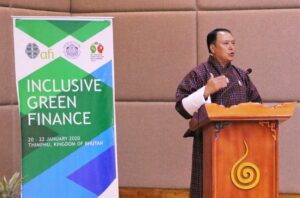9 February 2021
Bridging The Green Gap – The Role Of Central Banks
This article was published in IMPAKTER in February 2021.
by Johanna Nyman – Head of Inclusive Green Finance, Alliance for Financial Inclusion
In my professional life, I am privileged to work with central banks and other financial regulators who recognize the financial stability risks associated with climate change and environmental degradation. From broad strategies to more targeted policies, members of the Alliance for Financial Inclusion (AFI) are developing inclusive green finance initiatives that twin development and climate action.
As a rapidly evolving policy area, inclusive green finance is an important aspect of on-going green finance developments that draws focus on the most vulnerable humans in the most vulnerable economies. It emphasizes the ability of financial inclusion to empower those at the base of the economic pyramid so that they can build their own resilience to the impacts of climate change and lessen their own contributions to climate change and environmental degradation.
Access to credit, formal savings, insurance, and payment systems is enabling individuals and small businesses to adapt to both slow-onset and fast-onset climate change. Working in tandem are tailored financial products and services that are bolstering climate mitigation efforts. In South Asia, for example, the State Bank of Pakistan introduced a financing scheme for renewable energy projects while Bangladesh Bank brought in an annual five percent green finance regulatory target.

In the picture: One of the Green Finance Projects by AFI at Fiji Islands. Photo Credit: AFI, Alliance for Financial Inclusion.
Other examples from across the AFI network include the roll-out of a credit risk guarantee scheme for the agricultural lending, supported by the Bank of Ghana, and the national development and advancement of climate risk insurance for the agricultural sector, a process in which the Central Bank of Armenia was heavily involved.
Inclusive green finance is rapidly gaining traction, as this is addressing the vulnerabilities of those most vulnerable to the impacts of climate change. But in order to advance this policy area, and green finance more broadly national coordination and collaboration are urgently needed. Stakeholders on the national, regional, and international stage are showing significant demand for coordinated climate efforts and action between relevant actors. Looking ahead, they are also calling to venture beyond traditional climate and environmental parties by seeking alignment across mandates and responsibilities.
Central banks and financial regulators are in a prime position to not only contribute but also drive the global discussion on innovative and integrated approaches to climate change, as demonstrated in the AFI network endorsement of the 2017Â Sharm El Sheikh Accord on Financial Inclusion, Climate Change, and Green Finance.
By focusing on communities most exposed to the impacts of climate change, the Sharm Accord commits AFI members to work together and with partners to identify, understand and implement financial inclusion policy solutions that have positive outcomes for the environment. It also amplifies their actions to achieve targets set in the 2030 Sustainable Development Agenda and Paris Climate Agreement. As we race towards these goals, inclusive green finance policy initiatives – encouraged by central banks and financial regulators – are crucial in ensuring that no one is left behind.
Climate change and environmental degradation are increasingly treated as serious risks to security, finance, health, human livelihoods, and prosperity. In the 2021 Global Risk Report, climate action failure, biodiversity loss, human environmental damage, and extreme weather events were among the top 10 global risks.
Despite these challenges, I see a bright future. Mounting interest in developing green finance solutions – combined with regulatory willingness to facilitate technology and knowledge needed in the transition to low-carbon economies – provides reassurance and optimism. More importantly, governments are realizing that by alleviating poverty for the most vulnerable communities they stand to make economic gains and build resilience to the impacts of climate change. Regulators no longer see financial inclusion as a “bonus” to their efforts but have moved to make it a core component of their policy initiatives.

Governor Penjore of the Royal Monetary Authority of Bhutan, opening the Inclusive Green Finance Meeting in Thimpu, Bhutan in January 2020. Photo Credit: AFI, Alliance for Financial Inclusion.
My work in AFI has allowed me to see how powerful it can be to come together in shaping our common solutions. While much of the current data on climate change and environmental degradation is not very optimistic, I have also seen the results that we can achieve when all hands are on deck, and it is incredible.
The momentum of the on-going mobilization towards creating real change is something that offers me hope. It is about how new actors are joining the fight against climate change and how climate and environmental questions and solutions, have become the core of so many discussions.Â
The political will is there, paving the way for important policy innovations by financial regulators for a recovery that is both inclusive and green. This is essential given that climate change will be a source of future shocks that will require the building of financial resilience, especially for those at the base of the economic pyramid.
AFI’s Inclusive Green Finance workstream is part of the International Climate Initiative (IKI) supported by the German Federal Ministry for the Environment, Nature Conservation and Nuclear Safety (BMU), based on a decision of the German Bundestag.
About the Author / Johanna Nyman – Head of Inclusive Green Finance, Alliance for Financial Inclusion
Johanna is the Alliance for Financial Inclusion (AFI) Head of Inclusive Green Finance. She is supporting the AFI Network in developing and implementing Inclusive Green Finance Policies, aimed at building resilience and enabling mitigation at the base of the economic pyramid. Before joining AFI she worked with global climate policy, sustainable development, and climate security. She is originally from Finland and her educational background is in environmental sciences and climate policy.
About AFI:Â
The Alliance for Financial Inclusion (AFI) is the world’s leading organization on financial inclusion policy and regulation. Currently, 101 member institutions make up the AFI network including central banks, ministries of finance, and other financial policymaking or regulatory institutions from 90 developing countries and emerging markets. AFI empowers policymakers to increase the access and usage of quality financial services for the underserved through sustainable and inclusive policies and the effective use of digital technologies.
© Alliance for Financial Inclusion 2009-2024